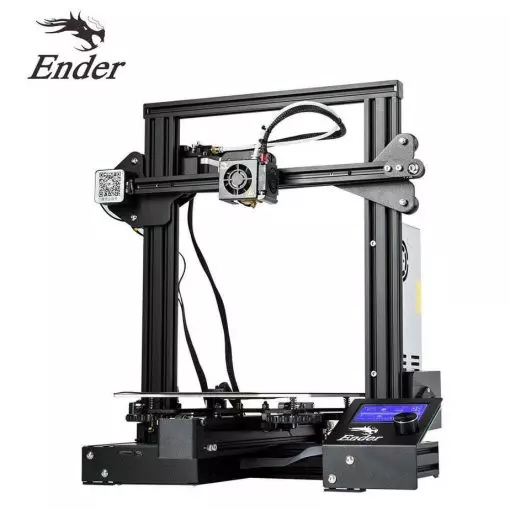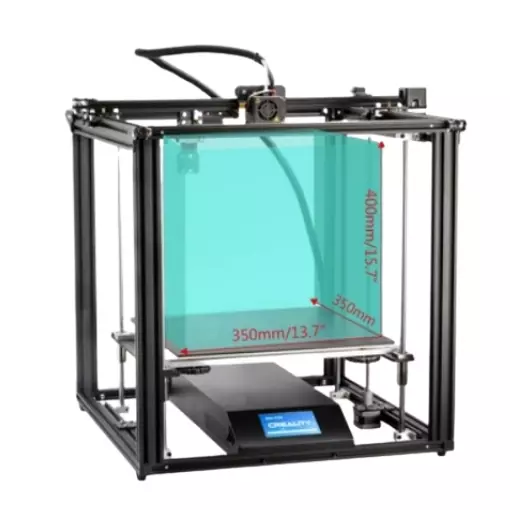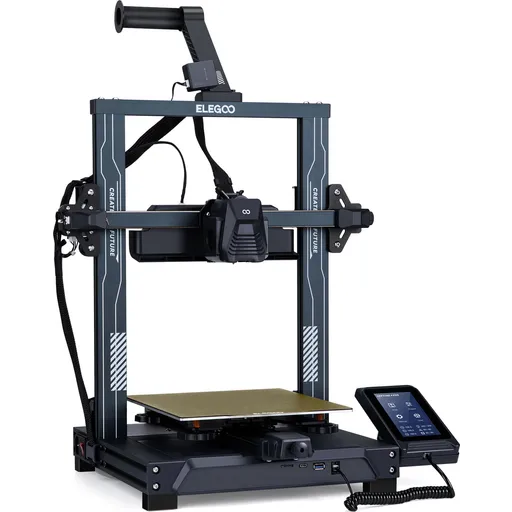Compare Ender 3 vs Ender 5 Plus vs Neptune 4 PRO
Comparison between the best 3D printers
Choose the best 3D printer at the best price. The cheapest 3D printers are here.
Buy a 3D printer here with 3D Fila.
 |
 |
 |
|
| Model | Ender 3[BUY Ender 3] |
Ender 5 Plus[BUY Ender 5 Plus] |
Neptune 4 PRO |
| Printing Material | Filament | Filament | Filament |
| Estimated price | $210,00 | $599,00 | $359,00 |
| Fabricante | Creality 3D | Creality 3D | Elegoo |
| Release Year | 2018 | 2019 | 2023 |
| Print Volume [mm] | 220x220x250 | 350x350x400 | 225x225x265 |
| Printer Size [mm] | 440x440x465 | 632x619x666 | 475x445x515 |
| Weight [kg] | 6,62 | 18,2 | 8,9 |
| Power Loss Recovery | NO | YES | YES |
| Enclosed printer | NO | NO | NO |
| Bed Leveling | Manual | Automatic | Automatic |
| Filament End Sensor | NO | YES | YES |
| Bed type | Heated | Heated | Heated |
| Power supply system | Bowden | Bowden | Direct Drive |
| Standard nozzle | 0,4 | 0,4 | 0,4 |
| Maximum Nozzle Temperature [°C] | 255 | 260 | 300 |
| Maximum Bed Temperature [°C] | 110 | 100 | 110 |
| Maximum printing speed [mm/s] | 180 | 180 | 500 |
| Filament holder | YES | YES | YES |
| Camera for supervision | NO | NO | NO |
| Recommended filaments | PLA, TPU, ABS, PETG | PLA, TPU, ABS, PETG | PLA, PLA+, TPU, PETG, Nylon, ABS |
| Recommended slicers | Cura, Simplify, Slic3r | Cura, Simplify, Slic3r | Bambu Studio, Super Slicer, Cura, Prusa Slicer, Orca |
| Maximum Resolution [mm] | 0,1 | 0,1 | 0,1 |
| Processor | 8 bits | 32 bits | ARM 64 bit |
| Display | Mono | Touchscreen TFT 4,3'' | Touchscreen 4,3'' |
| Power Supply | 24V / 270W | 24V / 504W | 310 W |
| Connectivity | SD / USB | SD / USB | USB, microSD |
| Operating systems | Windows, Mac, Linux | Windows, Mac, Linux | Windows, Linux, Macbook |
| Date of registration in the system | 2021-04-13 | 2021-04-14 | 2024-07-02 |
| Release date | 2018 | 2019 | 2023 |
| Extra features | The Ender 3 V1 is a DIY assembly 3D printer, a sales leader since 2017, standing out for its cost-benefit. With a wide printing capacity, it has a CNC machined structure for precision and stability. It offers high-precision prints with low noise, thanks to its innovative V-profile and pulleys. It has a self-adhesive magnetic platform for easy removal of models and excellent adhesion. The Ender 3 heats up quickly, reaching 100°C in 5 minutes, ideal for agile prints. It includes protection against power failures, allowing you to resume printing after interruptions, saving time and material. | The Ender 5 Plus offers a large print volume (350x350x400 mm) and fast assembly. It includes a BLTouch sensor, but with range limitations. It stands out for its dimensional accuracy, although it requires adjustments to the slicer settings. Despite the noise, its integrated design saves space, and includes features such as a filament sensor and power resumption. Ideal for large projects, it requires refinement in the settings for high-quality prints. | The Elegoo Neptune 4 Pro stands out for its advanced features, including pre-installed Klipper firmware, a dual-gear direct extruder with a 5.2:1 ratio, a high-temperature nozzle (up to 300°C), a flexible magnetic PEI platform, efficient cooling fans, and a 121-point auto-leveling system. The printer also features a 4.3-inch touchscreen interface, dual linear bars on the X and Y axes, and a segmented heated bed for energy savings. |
| Support for multiple colors and materials (AMS and CFS) | NO | NO | NO |
Notes * |
|||
| Cost-benefit | 6 / 10 | 6 / 10 | 7 / 10 |
| Hardware | 0.5 / 10 | 2 / 10 | 3.2 / 10 |
| Screen | . | . | . |
| Print volume | 3 / 10 | 4 / 10 | 3 / 10 |
| Performance | 1 / 10 | 1 / 10 | 4 / 10 |
| [BUY Ender 3] | [BUY Ender 5 Plus] |
Conclusion |
| In comparing the Ender 3, Ender 5 Plus, and Neptune 4 Pro, each 3D printer offers distinct advantages depending on your needs and budget. The **Ender 3** stands as an entry-level model, offering a very attractive price point with a decent print volume. While it lacks features such as automatic leveling and recovery from power loss, it remains a popular choice for beginners due to its reliability and solid performance. Its DIY assembly promotes a hands-on approach for those keen to understand the mechanics of 3D printing. However, the lower weight capacity and hardware limitations suggest that it may not be suitable for larger or more complex projects. The **Ender 5 Plus** provides a significant upgrade with a larger print volume and automatic bed leveling, making it more user-friendly for those looking to scale up their printing capabilities. Although priced higher, its dimensional accuracy and integrated design allow for better space management in work environments. However, users may need to adjust slicer settings for optimal results, which could be a consideration for less experienced users. It’s ideal for larger projects but may present challenges regarding noise and fine-tuning for quality prints. The **Neptune 4 Pro** represents the latest in technology among the three, and its advanced features justify its mid-range price. With a much higher maximum nozzle temperature and excellent cooling efficiency, it accommodates a broader range of materials, while the pre-installed Klipper firmware enhances printing speed and precision. Its automatic leveling system and direct drive extruder further streamline the printing process, making it suitable for both beginners and advanced users. The inclusion of a touchscreen interface adds to the user experience, though it is heavier than its counterparts. In summary, the **Ender 3** is best suited for budget-conscious beginners, providing good value for smaller projects. The **Ender 5 Plus** caters to those needing larger print capacity with added features for fine-tuning, albeit at a higher cost. Finally, the **Neptune 4 Pro** offers cutting-edge technology and versatility, justifying its price point for those willing to invest in more sophisticated 3D printing capabilities. Your choice should ultimately depend on your budget, experience level, and specific project requirements. |

